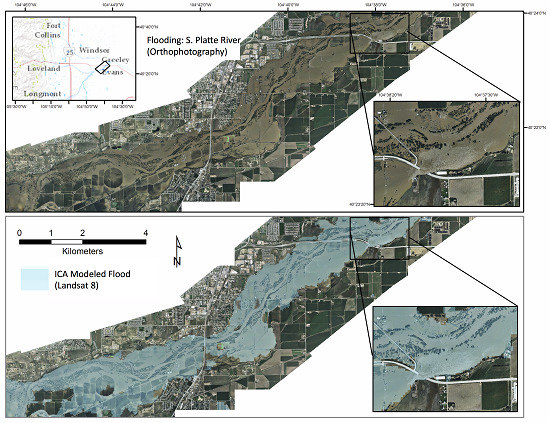Multi-Temporal Independent Component Analysis and Landsat 8 for Delineating Maximum Extent of the 2013 Colorado Front Range Flood
Abstract
:1. Introduction
2. Study Area and Flood Event Description
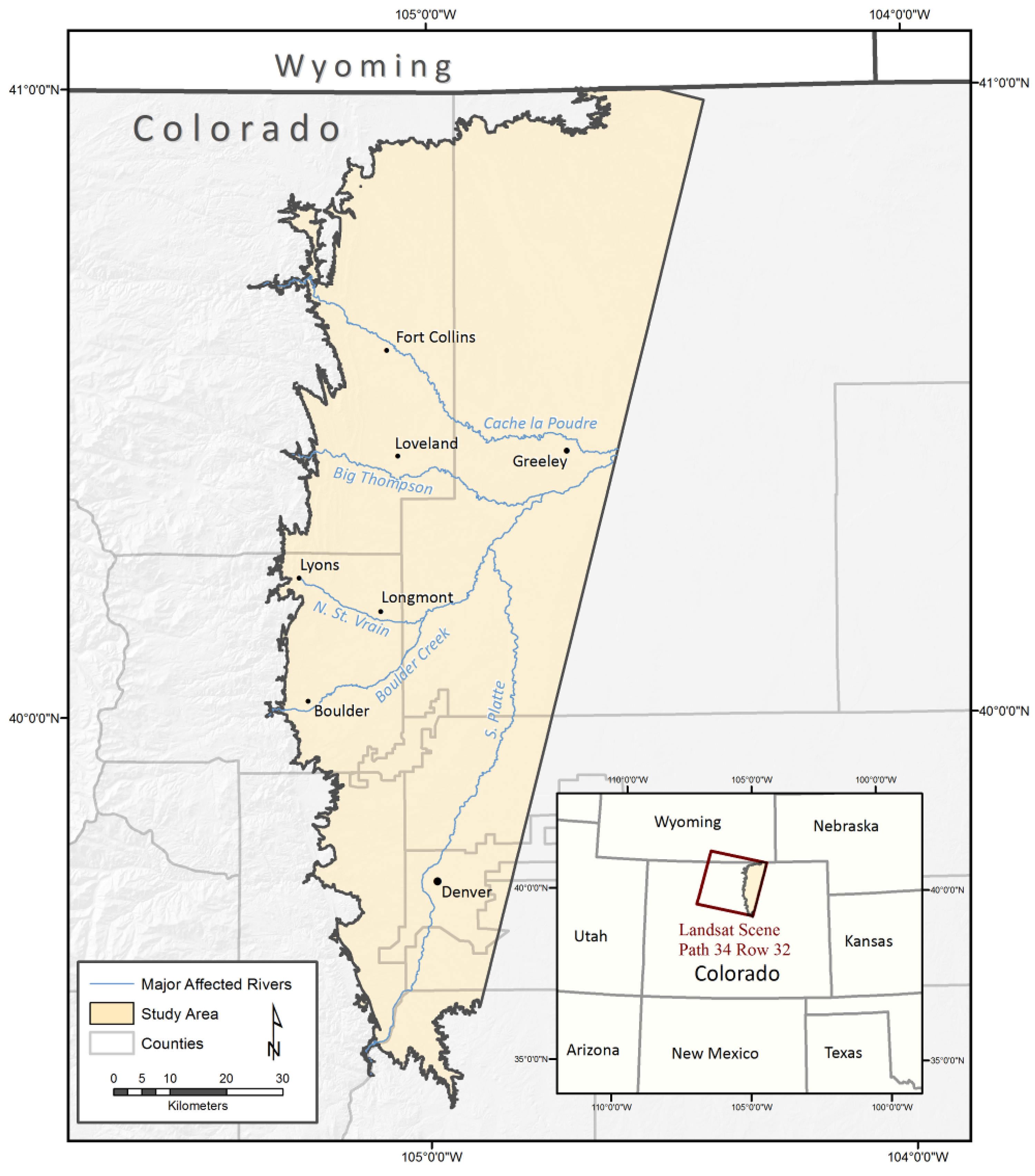
3. Methodology
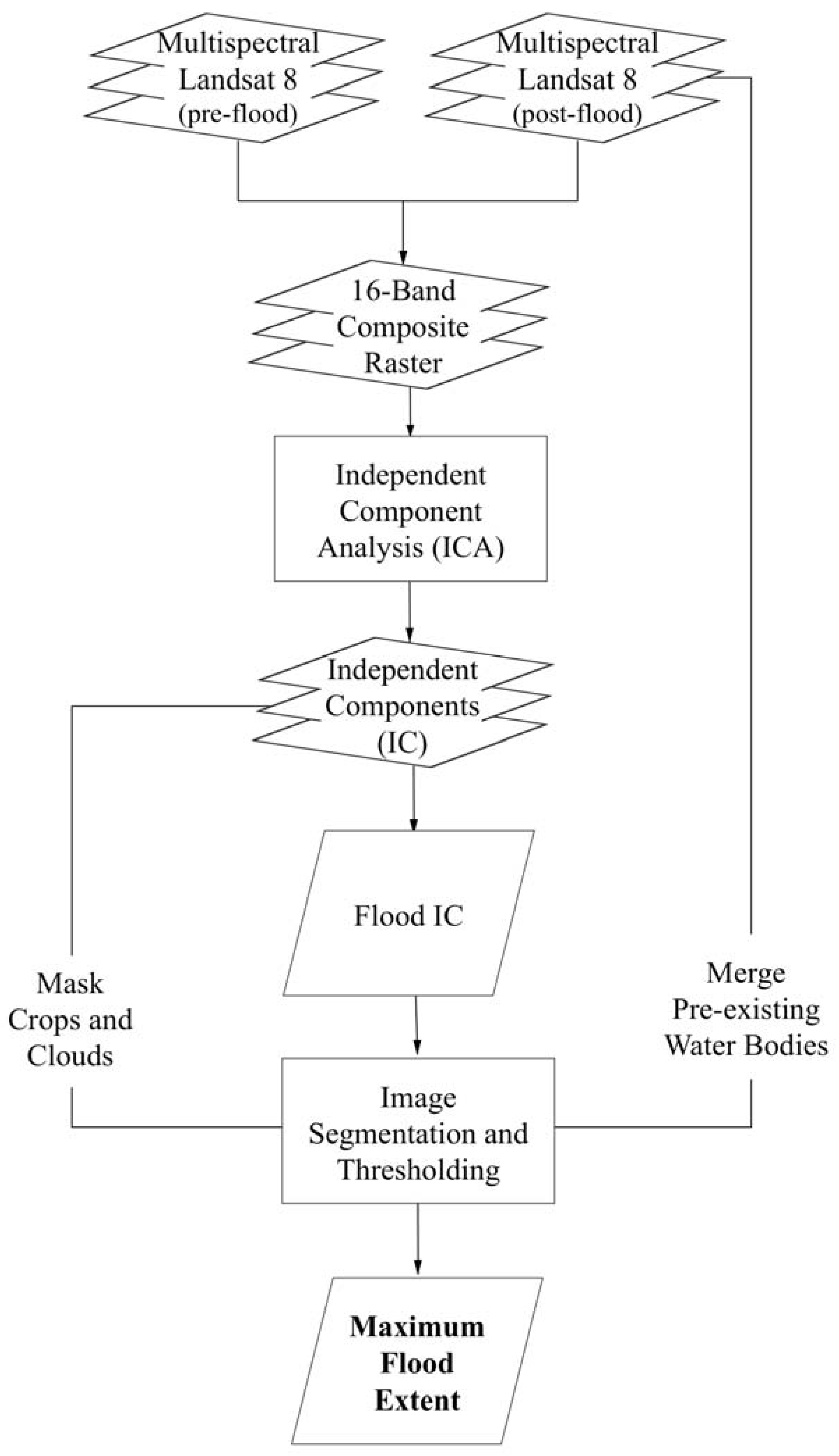
3.1. OLI Characteristics, Data, and Processing
3.2. Independent Component Analysis Change Detection
3.3. Addition of Existing Water Bodies

3.4. Crop and Cloud Masking
4. Results and Validation
4.1. Validation
4.1.1. Visual Validation
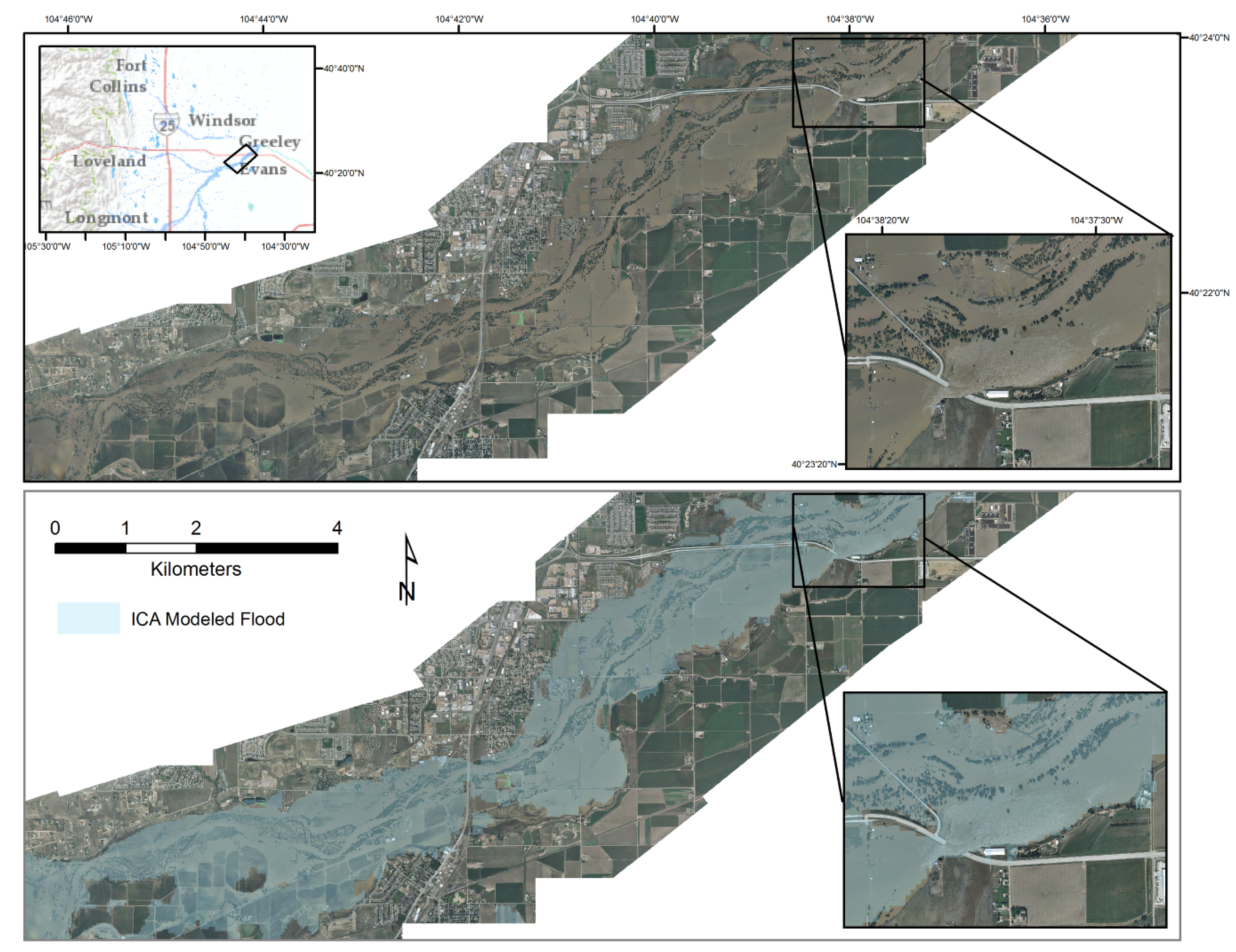
4.1.2. Pixel-to-Pixel Validation
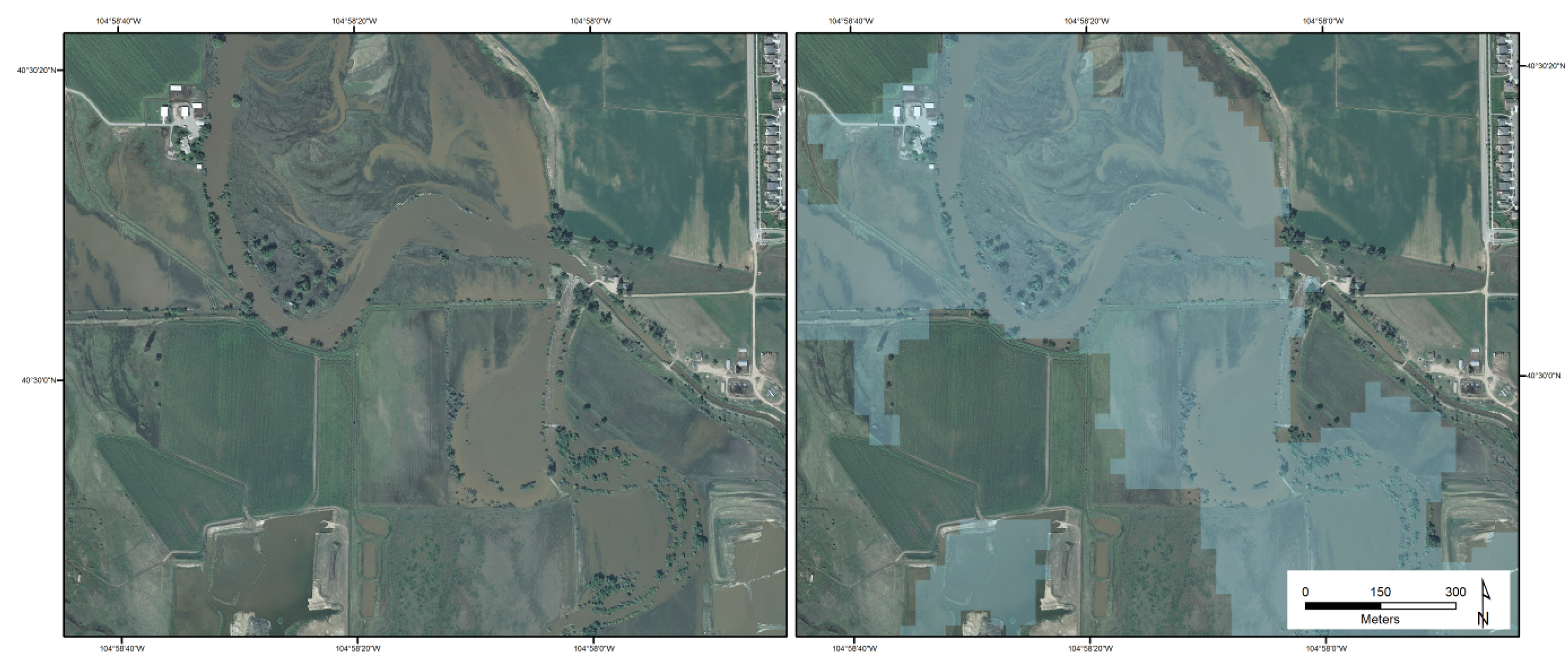
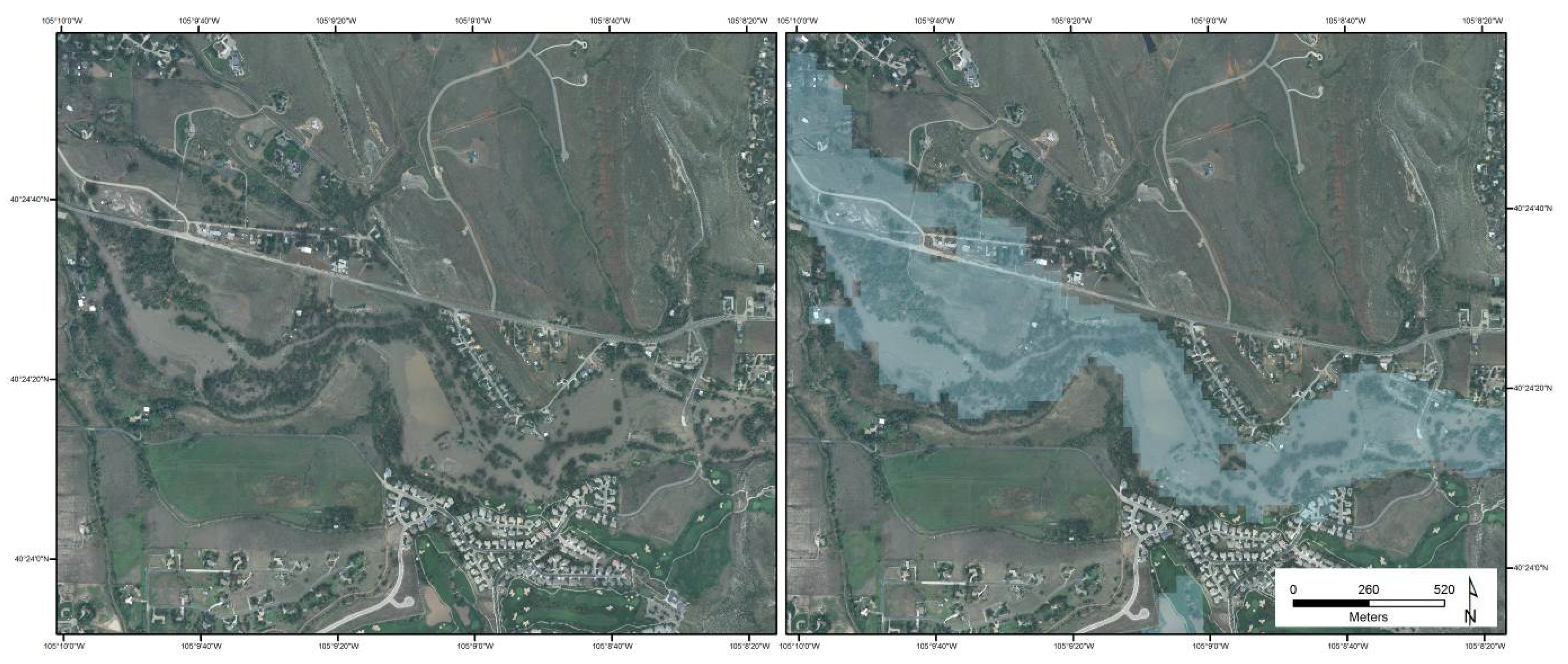
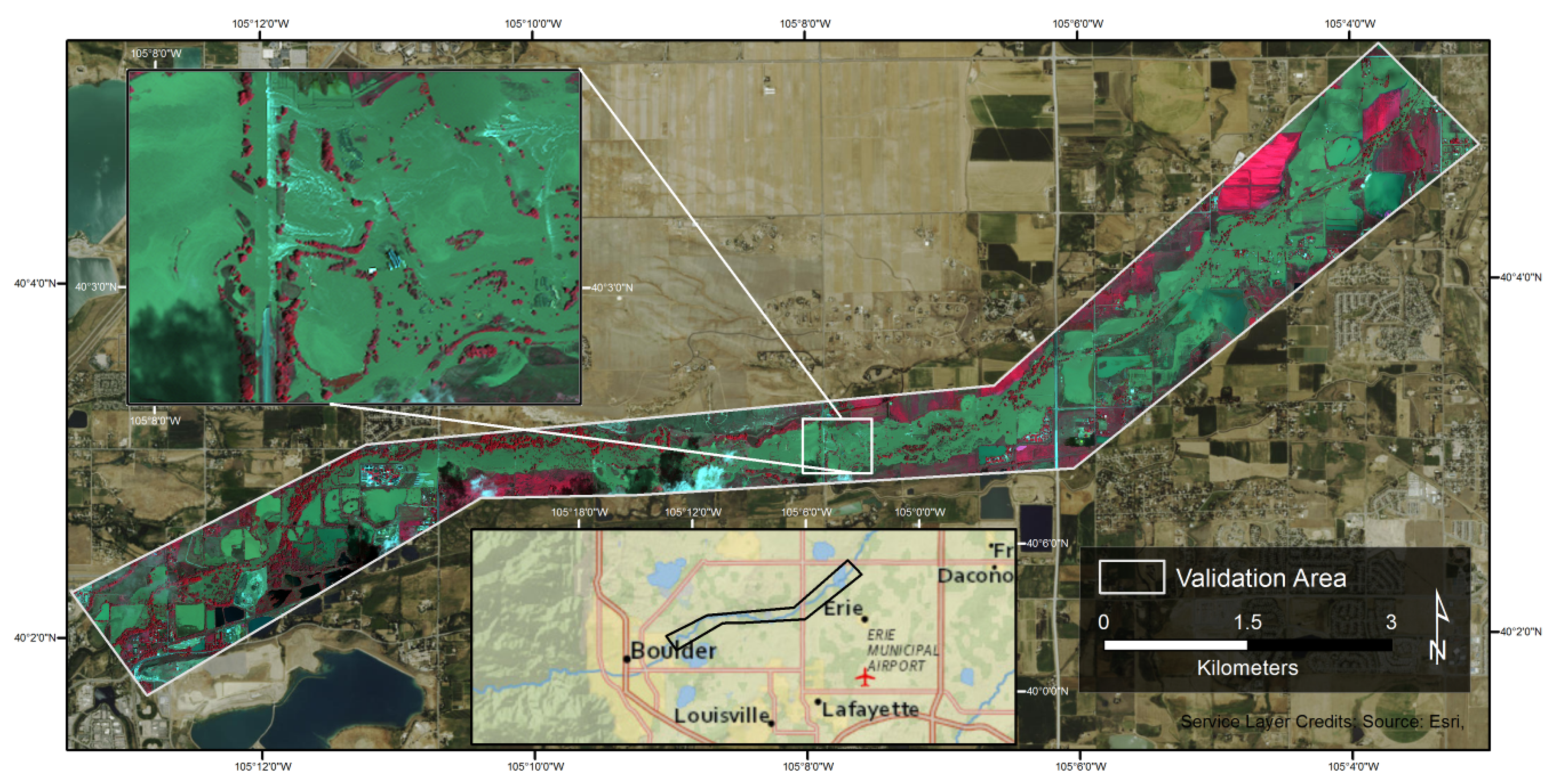

| Reference (WorldView-2) | |||||
|---|---|---|---|---|---|
| ICA | Flooded | Non-Flooded | Total | Producer’s Accuracy (%) | |
| Flooded | 8221 | 1395 | 9616 | 85 | |
| Non-Flooded | 1079 | 7772 | 8851 | 88 | |
| Total | 9300 | 9167 | 18467 | ||
| User’s Accuracy (%) | 88 | 85 | |||
| Overall Accuracy (%) | 87 | ||||
| Kappa Coefficient | 0.73 | ||||
| Reference (WorldView-2) | |||||
|---|---|---|---|---|---|
| MNDWI | Flooded | Non-Flooded | Total | Producer’s Accuracy (%) | |
| Flooded | 4145 | 179 | 4324 | 96 | |
| Non-Flooded | 5534 | 8609 | 14143 | 61 | |
| Total | 9679 | 8788 | 18467 | ||
| User’s Accuracy (%) | 43 | 98 | |||
| Overall Accuracy (%) | 69 | ||||
| Kappa Coefficient | 0.40 | ||||
| ICA Correct | ICA Incorrect | Total | |
|---|---|---|---|
| MNDWI Correct | 4029 | 116 | 4145 |
| MNDWI Incorrect | 4016 | 1381 | 5397 |
| Total | 8045 | 1497 | 9542 |
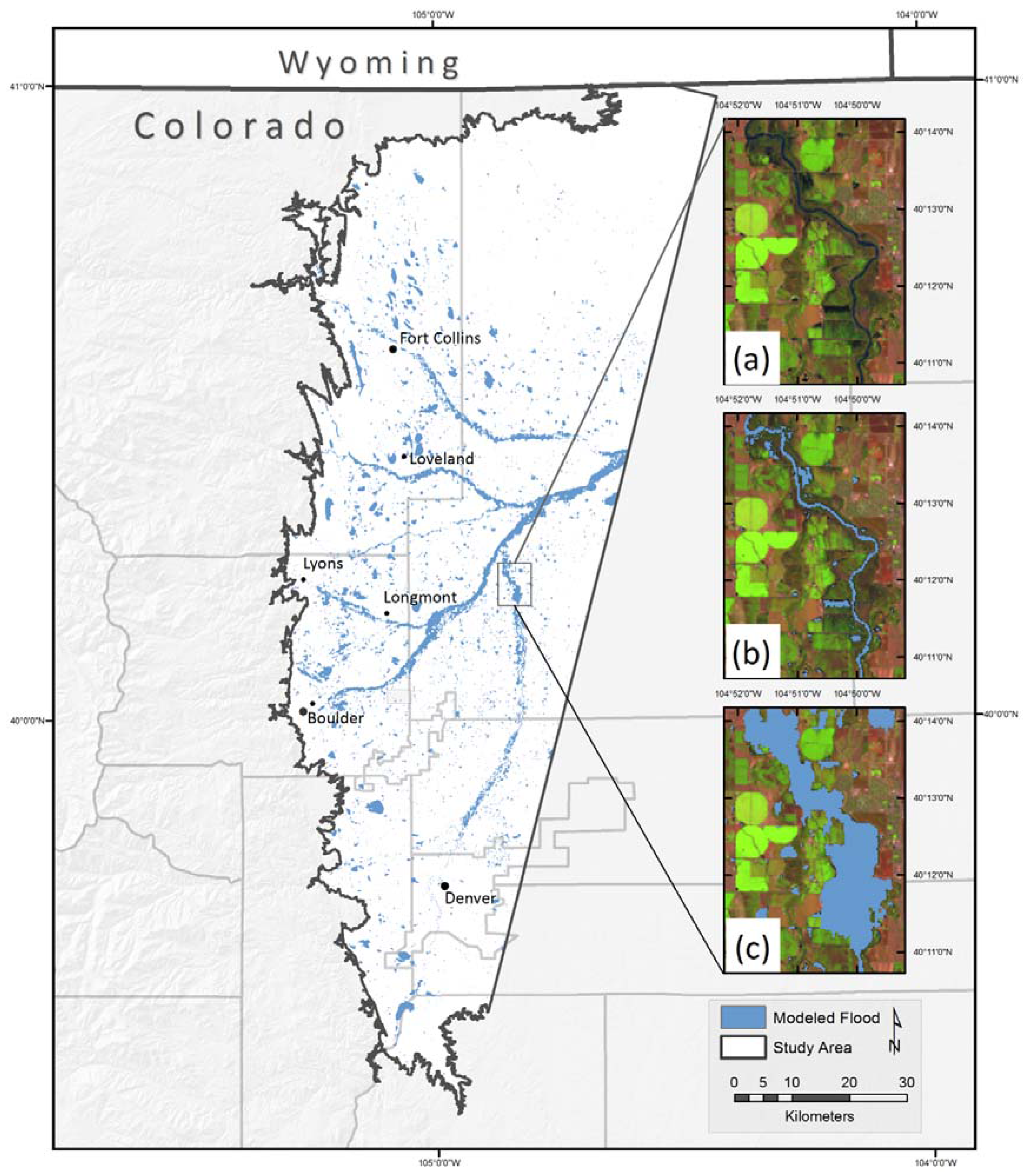
5. Discussion
5.1. Strengths and Advantages
5.2. Errors and Limitations
5.3. Future Work
6. Conclusions
Acknowledgments
Author Contributions
Supplementary Information
Conflicts of Interest
References
- Bates, B.C.; Kundzewicz, Z.W.W.; Wu, S.; Palutikof, J.P. Linking Climate Change and Water Resources: Impacts and Responses; IPCC Secretariat: Geneva, Switzerland, 2008. [Google Scholar]
- Stocker, T.F.; Qin, D.; Plattner, G.-K.; Tignor, M.; Allen, S.K.; Boschung, J.; Nauels, A.; Xia, Y.; Bex, V.; Midgley, P.M. Climate Change 2013: The Physical Science Basis. Contribution of Working Group I to the Fifth Assessment Report of the Intergovernmental Panel on Climate Change; AR5; IPCC: Geneva, Switzerland, 2013. [Google Scholar]
- Alsdorf, D.E.; Rodriquez, E.; Lettenmaier, D.P. Measuring surface water from space. Rev. Geophys. 2007, 45, 1–24. [Google Scholar] [CrossRef]
- Boori, M.S.; Voženílek, V. Remote sensing and GIS for socio-hydrological vulnerability. J. Geol. Geosci. 2014, 3, 1–4. [Google Scholar]
- Wang, Y. Mapping extent of floods: What we have learned and how we can do better. Nat. Hazards Rev. 2002, 3, 68–73. [Google Scholar] [CrossRef]
- Smith, L. Satellite remote sensing of river inundation area, stage, and discharge: A review. Hydrol. Process. 1997, 11, 1427–1439. [Google Scholar] [CrossRef]
- Schumann, G.; Bates, P.D.; Horritt, M.S.; Matgen, P.; Pappenberger, F. Progress in integration of remote sensing-derived flood extent and stage data and hydraulic models. Rev. Geophys. 2009, 47, 1–21. [Google Scholar] [CrossRef]
- Zhang, R.; Sun, Y. Rapid extraction of Pakistan floods from TM images. In Proceedings of the IEEE 2012 20th International Conference on Geoinformatics, Hong Kong, China, 15–17 June 2012; pp. 1–4.
- Amarnath, G. An algorithm for rapid flood inundation mapping from optical data using a reflectance differencing technique. J. Flood Risk Manag. 2013, 7, 239–250. [Google Scholar] [CrossRef]
- Ticehurst, C.; Guerschman, J.P.; Chen, Y. The strengths and limitations in using the Daily MODIS Open Water Likelihood Algorithm for identifying flood events. Remote Sens. 2014, 6, 11791–11809. [Google Scholar] [CrossRef]
- Opolot, E. Application of remote sensing and Geographical Information Systems in flood management: A review. Res. J. Appl. Sci. Eg. Technol. 2013, 6, 1884–1894. [Google Scholar]
- Wang, Y. Using Landsat 7 TM data acquired days after a flood event to delineate the maximum flood extent on a coastal floodplain. Int. J. Remote Sens. 2004, 25, 959–974. [Google Scholar] [CrossRef]
- Islam, A.S.; Bala, S.K.; Haque, M.A. Flood inundation map of Bangladesh using MODIS time-series images. J. Flood Risk Manag. 2010, 3, 210–222. [Google Scholar] [CrossRef]
- Li, S.; Sun, D.; Goldberg, M.; Stefanidis, A. Derivation of 30-m-resolution water maps from TERRA/MODIS and SRTM. Remote Sens. Environ. 2013, 134, 417–430. [Google Scholar] [CrossRef]
- Huang, C.; Chen, Y.; Wu, J. Mapping spatio-temporal flood inundation dynamics at large river basin scale using time-series flow data and MODIS imagery. Int. J. Appl. Earth Obs. Geoinf. 2014, 26, 350–362. [Google Scholar] [CrossRef]
- Wang, Y.; Colby, J.D.; Mulcahy, K.A. An efficient method for mapping flood extent in a coastal floodplain using Landsat TM and DEM data. Int. J. Remote Sens. 2002, 23, 3681–3696. [Google Scholar] [CrossRef]
- Gianinetto, M.; Villa, P.; Lechi, G. Postflood damage evaluation using Landsat TM and ETM+ data integrated with DEM. IEEE Trans. Geosci. Remote Sens. 2006, 44, 236–243. [Google Scholar] [CrossRef]
- Marchesi, S.; Bruzzone, L. ICA and kernel ICA for change detection in multispectral remote sensing images. In Proceedings of the 2009 IEEE International Geoscience and Remote Sensing Symposium, Cape Town, South Africa, 12–17 July 2009; Volume 2, pp. II–980–II–983.
- Zhong, J.; Wang, R. Multi-temporal remote sensing change detection based on independent component analysis. Int. J. Remote Sens. 2006, 27, 2055–2061. [Google Scholar] [CrossRef]
- Volpi, M.; Petropoulos, G.P.; Kanevski, M. Flooding extent cartography with Landsat TM imagery and regularized kernel Fisher’s discriminant analysis. Comput. Geosci. 2013, 57, 24–31. [Google Scholar] [CrossRef]
- Ireland, G.; Volpi, M.; Petropoulos, G. Examining the capability of supervised machine learning classifiers in extracting flooded areas from Landsat TM imagery: A case study from a Mediterranean flood. Remote Sens. 2015, 7, 3372–3399. [Google Scholar] [CrossRef]
- Comon, P. Independent component analysis, A new concept? Sig. Process. 1994, 36, 287–314. [Google Scholar] [CrossRef]
- Hyvärinen, A.; Oja, E. Independent component analysis: Algorithms and applications. Neural Netw. 2000, 13, 411–430. [Google Scholar] [CrossRef]
- Zhang, X. New independent component analysis method using higher order statistics with application to remote sensing images. Opt. Eng. 2002, 41, 1717–1728. [Google Scholar] [CrossRef]
- Hyvärinen, A. Survey on independent component analysis. Neural Comput. Surv. 1999, 2, 94–128. [Google Scholar]
- Windell, J.T.; Willard, B.E.; Cooper, D.J.; Foster, S.Q.; Knud-Hansen, C.F.; Rink, L.P.; Kiladis, G.N. An Ecological Characterization of Rocky Mountain Montane and Subalpine Wetlands; Denver Wildlifre Research Center, U.S. Fish and Wildlife Service: Denver, CO, USA, 1986; Volume 86. [Google Scholar]
- Wohl, E.E. Virtual Rivers: Lessons from the Mountain Rivers of the Colorado Front Range; Yale University Press: New Haven, CT, USA, 2001. [Google Scholar]
- United States Census Bureau. United States Census 2010; Government Printing Office: Washington, DC, USA, 2012. [Google Scholar]
- Yochum, S.E. Colorado Front Range Flood of 2013: Peak Flows and Flood Frequencies. In Proceedings of the 3rd Joint Federal Interagency Conference on Sedimentation and Hydrologic Modeling, Reno, NV, USA, 19–23 April 2015; pp. 1–12.
- USDA Lessons from the 2013 northern Colorado flood: Past, present, and future. Available online: http://www.fs.fed.us/rmrs/news/releases/content/?id=14-04-22 (accessed on 10 April 2015).
- Gochis, D.; Schumacher, R.; Friedrich, K.; Doesken, N.; Kelsch, M.; Sun, J.; Ikeda, K.; Lindsey, D.; Wood, A.; Dolan, B.; et al. The Great Colorado Flood of September 2013. Bull. Am. Meteorol. Soc. 2014. [Google Scholar] [CrossRef]
- Anderson, S.W.; Anderson, S.P.; Anderson, R.S. Exhumation by debris flows in the 2013 Colorado Front Range storm. Geology 2015, 43, 1–4. [Google Scholar] [CrossRef]
- Roy, D.P.; Wulder, M.A.; Loveland, T.R.; Woodcock, C.E.; Allen, R.G.; Anderson, M.C.; Helder, D.; Irons, J.R.; Johnson, D.M.; Kennedy, R.; et al. Landsat-8: Science and product vision for terrestrial global change research. Remote Sens. Environ. 2014, 145, 154–172. [Google Scholar] [CrossRef]
- Storey, J.; Choate, M.; Lee, K. Landsat 8 Operational Land Imager on-orbit geometric calibration and performance. Remote Sens. 2014, 6, 11127–11152. [Google Scholar] [CrossRef]
- Townshend, J.R.G.; Justice, C.O.; Gurney, C.; McManus, J. The impact of misregistration on change detection. IEEE Trans. Geosci. Remote Sens. 1992, 30, 1054–1060. [Google Scholar] [CrossRef]
- Du, Q.; Kopriva, I.; Szu, H. Independent Component Analysis for classifying multispectral images with dimensionality limitation. Int. J. Inf. Acquis. 2004, 1, 201–216. [Google Scholar] [CrossRef]
- Ceccarelli, M.; Petrosino, A. Unsupervised change detection in multispectral images based on Independent Component Analysis. In Proceedings of the International Workshop on Imaging System and Techniques, Minory, Italy, 29 April 2006; pp. 54–59.
- Lobell, D.B.; Asner, G.P. Moisture effects on soil reflectance. Soil Sci. Soc. Am. J. 2002, 66, 722–727. [Google Scholar] [CrossRef]
- Skidmore, E.L.; Dickerson, J.D.; Schimmelpfennig, H. Evaluating surface-soil water content by measuring reflectance. Soil Sci. Soc. Am. J. 1975, 39, 238–242. [Google Scholar] [CrossRef]
- ExelisVIS Independent Component Analysis. Documentation Center. Available online: http://exelisvis.com/docs/IndependentComponentsAnalysis.html (accessed on 29 January 2015).
- Pal, N.R.; Pal, S.K. A review on image segmentation techniques. Pattern Recognit. 1993, 26, 1277–1294. [Google Scholar] [CrossRef]
- Xu, H. Modification of normalised difference water index (NDWI) to enhance open water features in remotely sensed imagery. Int. J. Remote Sens. 2006, 27, 3025–3033. [Google Scholar] [CrossRef]
- Feyisa, G.L.; Meilby, H.; Fensholt, R.; Proud, S.R. Automated Water Extraction Index: A new technique for surface water mapping using Landsat imagery. Remote Sens. Environ. 2014, 140, 23–35. [Google Scholar] [CrossRef]
- Ji, L.; Zhang, L.; Wylie, B. Analysis of dynamic thresholds for the Normalized Difference Water Index. Photogramm. Eng. Remote Sens. 2009, 75, 1307–1317. [Google Scholar] [CrossRef]
- Homer, C.; Dewitz, J.; Yang, L.; Jin, S.; Danielson, P.; Xian, G.; Coulston, J.; Herold, N.; Wickham, J.; Megown, K. Completion of the 2011 National Land Cover Database for the conterminous United States—Representing a decade of land cover change information. Photogramm. Eng. Remote Sens. 2015, 81, 345–354. [Google Scholar]
- USGS National Water Information System. Available online: http://waterdata.usgs.gov/co/nwis/ (accessed on 29 January 2015).
- Villa, P.; Gianinetto, M. Multispectral transform and spline interpolation for mapping flood damages. In Proceedings of the 2006 IEEE International Conference on Geosceinces and Remote Sensing Symposium, Denver, CO, USA, 31 July–4 August 2006.
- Gianinetto, M.; Villa, P. Monsoon flooding response: A multi-scale approach to water-extent change detection. Int. Arch. Photogramm. Remote Sens. Spat. Inf. Sci. 2006, 36, 128–133. [Google Scholar]
- Morrison, R.; White, P. Monitoring Flood Inundation; United States Geol. Surv. Prof. Pap. 929; ERTS-1, A New Window on Our Planet; 1974; pp. 196–208. [Google Scholar]
- Rango, A.; Salomonson, V.V. Regional flood mapping from space. Water Resour. Res. 1974, 10, 473–484. [Google Scholar] [CrossRef]
- Merritt, D. Reciprocal relations between riparian vegetation, fluvial landforms, and channel processes. In Treatise on Geomorphology; Shroder, J., Wohl, E.E., Eds.; Academic Press: San Diego, CA, USA, 2013; pp. 219–243. [Google Scholar]
- Drusch, M.; Del Bello, U.; Carlier, S.; Colin, O.; Fernandez, V.; Gascon, F.; Hoersch, B.; Isola, C.; Laberinti, P.; Martimort, P.; et al. Sentinel-2: ESA’s Optical High-Resolution Mission for GMES Operational Services. Remote Sens. Environ. 2012, 120, 25–36. [Google Scholar] [CrossRef]
- Quartulli, M.; Olaizola, I.G. A review of EO image information mining. ISPRS J. Photogramm. Remote Sens. 2013, 75, 11–28. [Google Scholar] [CrossRef]
© 2015 by the authors; licensee MDPI, Basel, Switzerland. This article is an open access article distributed under the terms and conditions of the Creative Commons Attribution license (http://creativecommons.org/licenses/by/4.0/).
Share and Cite
Chignell, S.M.; Anderson, R.S.; Evangelista, P.H.; Laituri, M.J.; Merritt, D.M. Multi-Temporal Independent Component Analysis and Landsat 8 for Delineating Maximum Extent of the 2013 Colorado Front Range Flood. Remote Sens. 2015, 7, 9822-9843. https://doi.org/10.3390/rs70809822
Chignell SM, Anderson RS, Evangelista PH, Laituri MJ, Merritt DM. Multi-Temporal Independent Component Analysis and Landsat 8 for Delineating Maximum Extent of the 2013 Colorado Front Range Flood. Remote Sensing. 2015; 7(8):9822-9843. https://doi.org/10.3390/rs70809822
Chicago/Turabian StyleChignell, Stephen M., Ryan S. Anderson, Paul H. Evangelista, Melinda J. Laituri, and David M. Merritt. 2015. "Multi-Temporal Independent Component Analysis and Landsat 8 for Delineating Maximum Extent of the 2013 Colorado Front Range Flood" Remote Sensing 7, no. 8: 9822-9843. https://doi.org/10.3390/rs70809822
APA StyleChignell, S. M., Anderson, R. S., Evangelista, P. H., Laituri, M. J., & Merritt, D. M. (2015). Multi-Temporal Independent Component Analysis and Landsat 8 for Delineating Maximum Extent of the 2013 Colorado Front Range Flood. Remote Sensing, 7(8), 9822-9843. https://doi.org/10.3390/rs70809822




